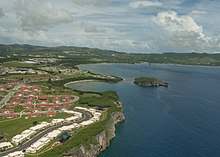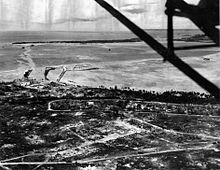Orote Peninsula

TheOrote Peninsulais a four kilometer-long peninsula jutting from the west coast of theUnited Statesterritory ofGuam.A major geologic feature of the island, it forms the southern coast ofApra Harborand the northern coast ofAgat Bay.Its tip,Point Udall,is Guam's westernmost point and also the United States' westernmost point bytravel,notlongitude.The peninsula historically was the site of the importantChamorrovillage ofSumay,as well asFort Santiagoof the Spanish colonial period. In modern times, the peninsula is politically in thevillageofSanta Rita,but it is controlled in its entirety byNaval Base Guam.
Geology
[edit]
Orote Peninsula, like the eastern Guam, is a raised limestone plateau reaching heights of 190 ft (58m).[1]Thelimestonedates to thePliocenetoPleistocene,known as "Mariana limestone." It thus differs dramatically from areas immediately inland, which are volcanic highlands.[2]It is believed that the TalofofoFaultthat runs fromGuamacross the island and throughOrdnance Annexruns along the southern edge of the Orote Peninsula.[3]
History
[edit]The peninsula was inhabited by multiple communities during the Pre-LattePeriod from 3,500 BC to 500 AD. These include:[4]
- The NHRP-listedOrote Historical Complex,which includes a cave complex located atPoint Udall(previously, Orote Point),[4]
- Gab Gab,on the northern side of the peninsula;[4]
- Orote Village, located next toDadi Beachon the south side; and[4]
- Sumay,which had a cave complex suggesting habitation well before European Contact.[5]
Spanish period
[edit]
In July 1676, during the period of theSpanish–Chamorro Wars,aJesuitmissionary was assigned to Orote. The job of this Jesuit was to conductbaptismsandmarriagesin the effort to solidify Spanish control of the island.[6]However, the village rebelled and was destroyed, with its population distributed to centralized villages where they could be better monitored and controlled.[4]
In the early 18th century, Spain'sCouncil of the Indiesgrew increasingly concerned about competing navies threatening theManila galleontrade and Spain's possessions in the Pacific.[7]This was aggravated by an attack in 1721 by the EnglishprivateerJohn Clippertonupon a supply ship fromCaviteanchored atMerizo.[8]In 1734, GovernorFrancisco de Cárdenas Pachecoopened up new anchorage inApra Harbor,which offered greater protection from attack.[7]Fort San Luiswas built in 1737 near current-day Gab Gab to protect the new anchorage.[9]A second battery,Fort Santiago,was built at Orote Point to guard the entrance to the harbor. One account suggests Fort Santiago began to be constructed in 1721. Thebatterywas large enough to house six cannon, and also had soldier's quarters and munitions storage.[10]In the 1800s, Sumay became a thriving port town, largely catering to thewhalingships.[5]However, the forts gradually deteriorated. In 1817,Otto von Kotzebuereported that Fort San Luis was no longer in use.[9]The three cannon at Fort Santiago were reported unusable in 1853 and, in 1884, GovernorFrancisco Olive y Garciadeclared that Fort Santiago was useful only as an observation post.[7]As a result, during the 1898Spanish–American War,the Spanish were unable to resist the Americancapture of Guam.[5]
20th and 21st centuries
[edit]
The Americans continued making the peninsula a center of military and economic activity. In 1903, theCommercial Pacific Cable Companylaidsubmarine communications cablefortelegraphthrough a station at Sumay, linking the United States to Asia, and each to Guam, for the first time. In the1920 census,Sumay was Guam's second most populous village with 1,209 residents.[5]On March 17, 1921, aU.S. Marine Squadronof 10 pilots and 90 enlisted men arrived and set up a base at Sumay for their amphibious aircraft, including a hangar. In 1926, the squadron built administration offices, but the next year was deployed to China to protect American lives in theNanking incident of 1927.On September 23, 1928,Patrol Squadron 3-Marrived on Guam as replacements. However, the U.S. decided that Naval Air Station Sumay was too expensive and shut it down on February 23, 1931.[11]
Guam's first golf course, Sumay Golf Links, was established in the village in 1923. This was followed byPan American Airwaysestablishing a base for itsChina Clipperin 1935 in Sumay, establishing the first trans-Pacific passenger air service. Pan American also built Guam's first hotel in the village.[5]

During theJapanese invasionon December 8, 1941, Sumay was targeted for bombing. The residents fled inland but were soon entirely evicted by the Japanese, who turned the town into a garrison. Sumay residents were moved to various concentration camps over theJapanese occupation of Guamfrom 1941 to 1944. The Japanese also constructedOrote Field,using Korean and Chamorro labor. Unlike the air station at Sumay, Orote Field was land-based, and used to refuel and rearm Japanese aircraft in the June 1944Battle of the Philippine Sea,but the field was destroyed by American raids. The U.S.initial U.S. invasion of Guamin July 1944 was designed to attack either sides of the heavily fortified Orote Peninsula, cutting it off from inland support. After fierce fighting, U.S. forces declared the peninsula secured on July 29, 1944. An estimated 3,000 Japanese soldiers died defending Orote Peninsula.[11]
After the end of thePacific War,the U.S. Navy refused to allow the Sumay residents to return, stating that the area was needed for the newNaval Base Guam,which would become a major military base into the 21st century. Sumay residents were relocated to Santa Rita, ending indigenous habitation of the peninsula.[5]
Other
[edit]- Orote includes the small settlement ofLockwood Terrace.
- The 2010 epilogue of the TV showLost,"The New Man in Charge",takes place on aDharma Initiativestation on the Orote Peninsula.[12]
References
[edit]- ^"Chapter 3. Geological and Soil Resources"(PDF).Guam and CNMI Military Relocation Final EIS.July 2010. p. 25.Retrieved2 March2021.
- ^"Geology of Guam".Digital Atlas of Southern Guam.Retrieved2 March2021.
- ^"Chapter 3. Geological and Soil Resources"(PDF).Guam and CNMI Military Relocation Final EIS.July 2010. p. 11.Retrieved2 March2021.
- ^abcde"Draft Joint Region Marianas Access Plan"(PDF).Naval Facilities Engineering Command Marianas. Archived fromthe original(PDF)on 2015-06-24.Retrieved2015-06-24.
- ^abcdefBabauta, Leo (October 14, 2019)."Sumay".Guampedia.RetrievedMarch 2,2021.
- ^Brunal-Perry, Omaira (January 19, 2021)."Matrimony and Social Change in the Marianas during Spanish Times".Guampedia.RetrievedMarch 2,2021.
- ^abcHaun, Daryl A. (October 10, 2019)."Fort Santiago".Guampedia.RetrievedMarch 2,2021.
- ^Murphy, Shannon J. (January 20, 2021)."Adventurers: John Clipperton and George Shelvocke".Guampedia.RetrievedMarch 5,2021.
- ^abHaun, Daryl A. (October 10, 2019)."Fort San Luis".Guampedia.RetrievedMarch 2,2021.
- ^"Spanish Forts of Guam Overview".Guampedia.October 16, 2019.RetrievedMarch 2,2021.
- ^ab"Orote Air Field".U.S. National Park Service.Retrieved2 March2021.
- ^"The New Man in Charge".Karen's LOST Notebook.25 August 2010.RetrievedMarch 2,2021.
